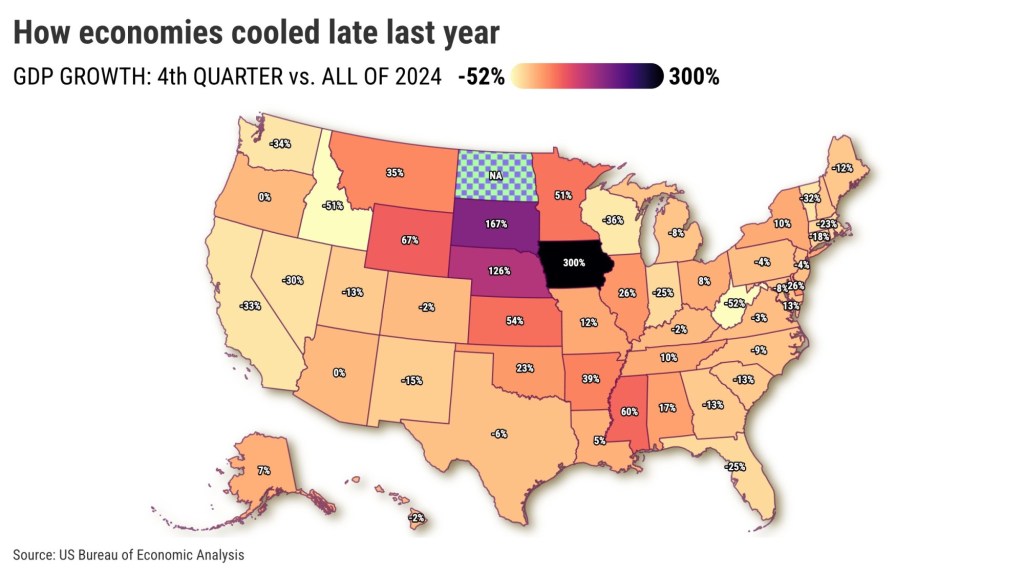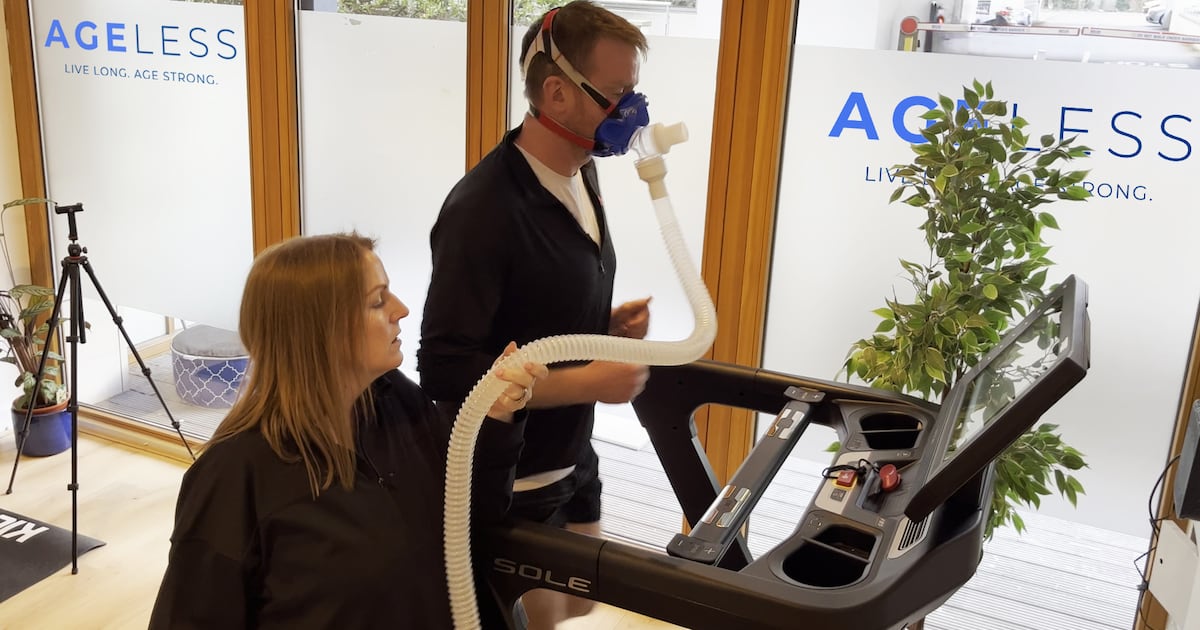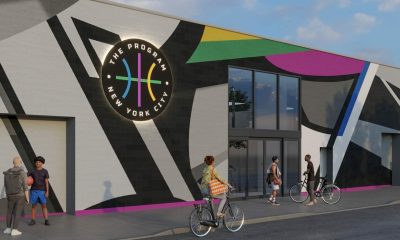
Technology
California jumps to world’s No. 4 economy. Can that last? – East Bay Times
California in 2024 claimed the world’s fourth-largest economy, by some curious math. Whether the state remains at this high, bragging-rights perch is very much in doubt. California businesses produced $4.1 trillion worth of goods and services in 2024, according to the latest gross domestic product estimates from the U.S. Bureau of Economic Analysis. GDP is […]

California in 2024 claimed the world’s fourth-largest economy, by some curious math.
Whether the state remains at this high, bragging-rights perch is very much in doubt.
California businesses produced $4.1 trillion worth of goods and services in 2024, according to the latest gross domestic product estimates from the U.S. Bureau of Economic Analysis. GDP is a broad measurement of economic production and is useful for comparisons of business heft.
When California’s economy is put on a global scale, only three nations were more productive last year, according to GDP stats from biannual reports from the International Monetary Fund.
The U.S. is easily No. 1 with $29 trillion, and it would still be tops without California. Next is China at $18.8 trillion. And there’s Germany at $4.66 trillion.
The “big news” is that California managed to bump up from its long-standing No. 5 ranking on this global totem pole by edging past Japan, which produced $4.03 trillion in GDP last year.
California is an economic powerhouse because its 18-million-people-strong workforce isn’t just the nation’s largest, it produces highly valued products. For all the talk of California’s “anti-business” policies, no state comes close to the Golden State in business output.
Texas is the nation’s No. 2 in GDP at $2.7 trillion. My trusty spreadsheet, using California’s bragging-rights calculations, found Texas ranks as the world’s No. 8 economy, on par with Italy.
New York’s $2.3 trillion GDP is No. 9 globally. That’s Canada’s ballpark. Florida, at $1.7 trillion, is No. 16, or roughly the size of Indonesia. And Illinois, at $1.1 trillion, is No. 19, comparable with Saudi Arabia.
Big headaches
Think about the challenges California’s lofty global ranking economy faces.
Start with the strength of the U.S. dollar. Its rise has been a relative economic norm for over a decade.
These economic rankings are made possible by converting the worldwide business output into its top currency, the American one. A strong U.S. dollar makes domestic output pricier to our global trading partners. It also devalues foreign production.
So ponder how currency gyrations affected the calculations of Japanese growth.
Throughout 2024, the Japanese yen lost 11% of its value compared with the U.S. dollar. That’s a key reason why Japan’s GDP growth was 2.9% for the year in yen, but only 0.1% in dollars.
That story is different today. In 2025’s first four months, the two currencies flip-flopped. The yen has appreciated 10% against the dollar as currency traders weigh trade wars started by the Trump administration and what they will do to the world’s business production.
It’s possible that California would lose the No. 4 spot on the GDP scorecard if output were priced at today’s currency rates.
Then there’s India, with an economic competition I’ve previously mentioned when writing about California’s GDP rank.
India is the world’s most populous nation with 1.46 billion people. California has “only” 40 million. India is blooming into one of the world’s economic superpowers that will surely surpass California’s output some year soon.
India’s $3.91 trillion GDP in 2024, just behind Japan. The IMF projects then Indian economy to grow 6.2% in U.S. dollars in 2025. Assuming California’s GDP can grow at the estimated 1.8% U.S. rate, the Indian economy could surpass the Golden State this year.
Of course, the immense wildcard in any chat about the world’s economy today is the business turmoil created by the Trump administration. Its ever-changing attempts to right what it perceives as the world’s unfair trading practices makes any business forecast a raw guestimate, at best.
We see new U.S. tariffs and ensuing retaliation by the targeted nations – plus talk of ripping up existing trade deals. Which national economies will win or lose these trade wars – not to mention California’s globally focused business climate? Who ends up where on the 2025 global GDP ladder?
It’s a big unknown.
Slow ending
California’s No. 4 global ranking is a fun fact, but it can’t hide a decidedly cooling economy.
Look at the state’s GDP growth against its domestic competition.
Last year, California’s business output grew 6% using the same GDP math. That was ninth-best among the states and topped the 5.3% national expansion.
However, the year’s end was worrisome.
GDP growth in California cooled to a 4% annual rate in the fourth quarter. A key factor is that the state’s information industries – from Silicon Valley to Hollywood – faced steep challenges.
That end-of-the-year expansion ranked No. 40 among the states and trailed the 4.8% U.S. pace.
So, California’s economic growth cooled by 33% when comparing all of 2024 to its finish. The nation’s growth shrank only 9%. And only four states slowed more than the Golden State.
Jonathan Lansner is the business columnist for the Southern California News Group. He can be reached at jlansner@scng.com
Technology
Live Sports Streaming Pushes Demand for Immersive Volumetric Video
Company Logo Growth in the volumetric video market is driven by advancements in 3D capture, powerful infrastructure, and strategic investments in AR/VR technologies. Key players include Microsoft, Intel, and Google, with North America leading market share. Applications span media, sports, and gaming, while emerging markets in APAC and Latin America show strong growth potential. Volumetric […]

Growth in the volumetric video market is driven by advancements in 3D capture, powerful infrastructure, and strategic investments in AR/VR technologies. Key players include Microsoft, Intel, and Google, with North America leading market share. Applications span media, sports, and gaming, while emerging markets in APAC and Latin America show strong growth potential.
Volumetric Video Market
Dublin, May 28, 2025 (GLOBE NEWSWIRE) — The “Volumetric Video Market – Global Outlook & Forecast 2025-2030” report has been added to ResearchAndMarkets.com’s offering.
The Volumetric Video Market was valued at USD 2.55 Billion in 2024, and is projected to reach USD 10.29 Billion by 2030, rising at a CAGR of 26.18%.
Volumetric video represents a paradigm shift in digital content, enabling three-dimensional capture of people, objects, and environments. Unlike traditional videos, it allows users to interact with content from 360-degree perspectives, offering deeply immersive, lifelike experiences. The demand for such realism is being accelerated by consumers’ growing appetite for interactive media and spatial computing.
Despite the high cost and lack of standardization in 3D content creation, the volumetric video market is gaining strong momentum due to several pivotal developments:
-
Technological Advancements: Innovations in 3D capture, including high-definition cameras, LiDAR sensors, and multi-view photogrammetry – are enhancing video quality and reducing production complexity.
-
Powerful Infrastructure: The rising availability of high-performance GPUs, edge computing, and cloud-based storage solutions is solving the massive data demands of volumetric content.
-
Strategic Investments: In 2024, Gracia AI invested USD 1.2 million into next-gen volumetric video tools tailored for spatial computing, highlighting growing investor confidence.
Furthermore, major tech companies such as Meta, Microsoft, and Apple among others are gradually investing in AR/VR technologies which shows the growing need for immersive experiences in digital space. In 2023, Apple also introduced its Vision Pro headset during the Worldwide Developers Conference (WWDC) which was released globally in 2024 and includes multiple cameras to enable mixed reality, eye and hand tracking for interaction. Thus, the expanding innovations in AR and VR technology are significantly contributing to the volumetric video market growth.
VOLUMETRIC VIDEO MARKET TRENDS & DRIVERS
Rising Demand in the Live Sports & Entertainment Industry
The live streaming sports events have revolutionized sports content for its consumers in recent years. Major platforms like ESPN+, DAZN, Amazon Prime, and social media channels like YouTube and Facebook have witnessed significant user engagement in sports streaming. For instance, in 2023 DAZN became Europe’s biggest digital sports broadcaster app and has around 15 million subscribers worldwide. In 2022 Amazon Prime Video recorded over 25 million viewers for its extensive NFL Thursday Night Football streams. Hence, the rapid expansion of live sports and entertainment industries has gradually boosted the volumetric video market.
Advancing Volumetric Videos Realism with Generative AI
In volumetric videos generative AI is significantly enhancing the realism of immersive media experiences, thereby propelling the growth of the market. Generative AI refines the 3D capabilities fills the missing data and improves the resolution of volumetric video which makes it more lifelike and engaging. Moreover, the integration of AI in volumetric video is transforming the immersive content as AI enhances the quality of volumetric captures by improving its resolution and texture refining to make it more real. The usage of AI also reduces the manual effort required in postproduction enabling faster and cost effective content creation.
Improvements in 3D Capture & Displays
The volumetric video market witnessed significant advancements in recent years driven by the increasing demand for various sectors like entertainment, education, and healthcare. The development of affordable 3D cameras and sensors is one of the major advancements of the volumetric video market. Further, companies are also increasingly investing in high-resolution depth sensors LiDAR technology, and multi-camera systems to improve the quality and efficiency of 3D captures. For instance, companies like Gracia AI use Gaussian splatting to record volumetric videos viewable on devices such as the Meta Quest headsets allowing users to observe scenes from various angles and enhance their experience.
Revolutionizing Gaming & E-Sports
The global volumetric video market is changing the gaming industry as is used in applications like character animation, world construction, and player immersion. Game makers use these types of videos to capture real-life performances and incorporate them into gaming environments such as live creatures with realistic reactions and motions which improves the gaming experience of players by offering more engaging and immersive experiences. For instance, in 2024, Arcturus, a volumetric video developer company, introduced an update for its HoloSuite software that transfers lightweight, scalable volumetric video into game engines which allows it to execute and playback in real-time. Further, by using a new high-performance codec, Accelerated Volumetric Video (AVV) users can populate digital scenes with more volumetric characters than has typically been possible and at the same time maintain a higher level of data quality.
Technology
‘To be above average later in life, you need to be above average now’ – The Irish Times
High levels of aerobic fitness are the best predictor of longevity, according to cardiologist Dr Paddy Barrett, who has attracted an international following for his expertise in prevention of heart disease. Feeling how puffed you are after running up two flights of stairs might be a clue to how you are faring on that front. […]

High levels of aerobic fitness are the best predictor of longevity, according to cardiologist Dr Paddy Barrett, who has attracted an international following for his expertise in prevention of heart disease.
Feeling how puffed you are after running up two flights of stairs might be a clue to how you are faring on that front. But a more insightful and scientific approach is to measure your VO₂ max. This is the maximum rate at which your body can transport and use oxygen to fuel muscles, expressed in millilitres of oxygen consumed per minute per kilo of body weight.
“The higher your VO₂ max, the longer you are likely to live and the less likely you are to develop the major chronic diseases of heart disease, cancer and dementia early in life,” says Dr Barrett, a specialist in heart disease prevention and cardiovascular risk management at Blackrock Health in Dublin and author of Heart: An Owner’s Guide (Dorling Kindersley, 2024).
No wonder then that there is growing interest in this key “metric” for the probability of enjoying a longer lifespan and, perhaps more crucially, an extended healthspan, ie well enough to enjoy an independent and active life. Of course, the proverbial bus, literal or metaphorical, can still come along to confound any such expectation, but it is an important indicator of odds.
More than half the Irish population have a smartwatch on their wrists and many will be familiar with at least the option of using it to get a VO₂ reading. But these are estimates conjured up by algorithms based on the device’s measurement of pace and heart rate, with no breath analysis involved. Some brands are regarded as better than others in their fine tuning of those algorithms for accuracy
Long before the development of consumer wearable trackers, American doctor Kenneth Cooper devised a test for the US military in the 1960s to measure aerobic fitness. This is still popular today as a self-test for VO₂ max. It involves measuring how far you can run in 12 minutes and putting that figure into an online Cooper test calculator. The result can be used to look at how your VO₂ max compares within the range for your gender and age group.
However, the only way to get an accurate VO₂ reading is to take a test wearing a mask connected to a machine that assesses the body’s oxygen consumption while gentle movement is ramped up to full exertion. A process that was once confined to elite sports circles and research labs is becoming increasingly available to anyone interested in learning more about their fitness. Some corporate workplaces now organise on-site testing as a perk for employees.
Seán Kinane came across VO₂ max testing when he was working in a gym in Perth, Australia, in 2009. Two years later, he set up Health Matters based in a gym in Tallaght, Dublin, working with athletes from a variety of sports. But he has seen demand grow “exponentially” in recent times.

“We’re doing nearly more tests in a week now than we did in a year,” he says of both VO₂ and resting metabolic rate testing, with work in corporate care having taken off in the last few years. He attributes this to people generally being more aware of health and fitness post Covid, and also to the influence of global guru Dr Peter Attia, “beating the drum from America about the longevity aspects of VO₂”.
[ How to be happy as you grow older: ‘Get out and keep going’Opens in new window ]
The link to longevity is very much the focus of siblings Elizabeth and Daniel O’Mahony, who this month opened AgeLess in South Dublin to offer testing for VO₂ max and/or resting metabolic rate. (The latter calculates the number of daily calories an individual needs to function while at rest and is used as a tool in weight management, be that to lose, gain or maintain.)
“We’re not saying that we’re going to increase people’s lifespans or make people live to 100,” says Daniel, sitting with his sister in a pristine office suite in Sandyford’s South Beacon Quarter. But they are confident that their “gold standard” equipment here can give people very useful data for longevity and working towards fitness goals, be that to run a first marathon or still be able to play a round of golf at 85.
Test results, he explains, can help predict what decade physical activities are likely to start to become difficult for an individual if they continue on their current health trajectory. An individual’s VO₂ max typically declines by up to 10 per cent for every decade after the age of 25 to 30 but exercise helps counter the extent and impact of that decrease.
AgeLess is a significant change of direction for the O’Mahonys who were both involved in the family property business for about 20 years. They were looking for an opportunity to strike out on their own and share their passion for health and wellbeing, sharpened by the experience of the Covid pandemic
Daniel, who is 39 and a former smoker, says that, like many millennials, he did not think about long-term health in his 20s. But then he became an avid runner and participates in ultra endurance events. He finished 72nd in the 2021 Marathon des Sables, a gruelling seven-day race covering 250km in the Moroccan desert, and now has his sights set on next year’s Ultra Trail Mont Blanc, a 117km run around the mountain involving an elevation gain of 10,000m.
[ Do we really need 10,000 steps a day to stay healthy?Opens in new window ]

Elizabeth, who is 44 and a mother of two children, aged seven and four, has only taken up running recently. Motherhood, particularly having her second child during the Covid pandemic, made her more aware of her own health and the importance of physical activity for the whole family. “For me just being able to get out and have a run in the evening or at the weekend is great for the soul. I wouldn’t be doing ultra marathons or anything like that, but I’ve signed up now for the Women’s Mini Marathon on the 1st of June,” she says.
So what is involved in this test to find out how well your heart and lungs deliver oxygen to muscles? At AgeLess, there is the choice of doing it on a treadmill or exercise bike – or on your own bike fixed on a stand.
For those using the treadmill, the speed and incline is gradually increased as their respiratory exchange rate (RER) is measured through the use of mask and tubing connected to a monitor, for the VO₂ max calculation. At initial walking pace, the RER will read 0.8, indicating that the person is using fat as their primary fuel source.
“As they get to a higher level of output on their exercise,” says Daniel, “they switch over into carbohydrates as their main fuel source and the RER will have gone from 0.8 up to 1.0 and then when it hits 1.1 for anyone, that’s considered a maximum effort.” At that point all the necessary data has been captured and while more competitive clients may persevere for a bit longer, others will indicate they can do no more with a thumbs down or by hitting the stop button.
“The test itself normally lasts between 12 and 15 minutes and the last three minutes are probably the hardest for people because that’s when they’re actually getting to their threshold,” says Elizabeth. Non-runners can opt to do a walking test using steeper inclines on the treadmill.
The information readouts, which include tracking of heart rate, calories burned through the exercise test and speed of heart rate recovery, are then put in context for the client. The VO₂ max score is only part of somebody’s fitness story. But once they know their baseline, the next thing to be thinking about is how to increase that.

Dr Barrett’s advice is: “If you want to be above average later in life, you need to be above average now. Falling into the ‘average’ range for your age and sex is not good enough. You need to be above average at a minimum, but ideally in the top 25 per cent.”
AgeLess is partnering with personal trainers, nutritionists and physiotherapists to work with clients seeking detailed, professional advice on how to act on what their VO₂ max result is telling them. They may want to look at improving their lean muscle mass and their nutrition.
If clients choose to have their resting metabolic rate (RMR) measured as well, or come in just for that, the test involves simply sitting on a sofa connected to a monitor for 20 minutes. Both tests, as part of a “longevity bundle”, cost €150. Individually, the fee for VO₂ max analysis is €110 and €80 for RMR analysis.
“Having a good, lean muscle mass with a high VO₂ max is the ideal place to be,” says Daniel, who stresses that small, compound behavioural changes add up over time. “What we would ideally like to do is get our clients, over the years, up into that 75th percentile; to have everyone aiming for what is quite an achievable percentile to be in.”
Ciaran Burke of The Performance Lab (thepeerformancelab.ie) in Clonmel, Co Tipperary, has also seen a surge of interest in knowing and tracking this fitness marker. A strength and conditioning coach who became an exercise physiologist six years ago, Burke was mainly providing testing to athletic and triathlon clubs at the outset but now goes into mainstream gyms.
With rising participation in Hyrox and other forms of hybrid fitness training, people “are just trying to find the little percentages that the athletic world, or the endurance world, already knows about”, Burke suggests. “My guiding principle is to make sure they know how to inject what they’ve learned into their training.”
While the majority of his work is still sports performance related, Burke notes that there are also people in their 60s and 70s coming to him to get a VO₂ test “just to sort of get a handle on what’s going on”.

After a baseline test to inform somebody’s fitness training, noticeable change should be achievable within 12 to 15 weeks if they are following their programme correctly, he says. But he finds people are “shocking” at judging intensity of training. The rough guide for increasing VO₂ max is that just 20 per cent of training should be high intensity for that individual, while the rest is slow, steady effort.
A person’s VO₂ max is not the be all and end all, explains Kinane. An athlete with a lower level could outperform a fellow competitor with a higher VO₂ max because they train smarter. It is a number that “doesn’t guarantee performance, it guarantees potential,” is how he likes to put it. “It’s learning about how to use that through training zones and energy systems and fuelling. And that’s where the metabolic analysis then complements the VO₂ stuff.”
Elite athletes apart, dietitian Sarah Keogh of Eat Well is a bit dubious about the value for the average person of knowing the very precise number of daily calories their body needs just to function. In her work, RMR is occasionally used for somebody, say, being tube fed in an intensive care unit.

However, she acknowledges that for some people this number can be very motivating in calculating and sticking to an eating plan. Her main concern is where it might increase food anxiety and rigidity over daily consumption, to the detriment of good mental health and a social life.
Technology
AppSignal Expands to Texas with $22M for U.S. Growth
(KNUE-FM) We keep hearing that the great migration to Texas is coming to a close. But we’re not so sure about that when we hear about big U.S. companies moving their headquarters to Texas. Particularly when European tech companies move to the Lone Star State. European Tech Finds a New Home in Texas Are you […]

(KNUE-FM) We keep hearing that the great migration to Texas is coming to a close. But we’re not so sure about that when we hear about big U.S. companies moving their headquarters to Texas.
Particularly when European tech companies move to the Lone Star State.

European Tech Finds a New Home in Texas
Are you familiar with the growing tech company, AppSignal?
If not, you’re not alone.
AppSignal is a growing tech company that has built a strong reputation for helping software teams accomplish their clients’ goals. Founded in 2013 in Amsterdam, AppSignal creates tools for developers to keep apps and websites running properly.
According to My San Antonio, it has now raised $22 million to expand its enterprise.
And with that money? They’re moving to Texas. Austin, specifically.
Why Texas Made Sense
Well, you can likely guess why.
AppSignal was looking for a blend of ingredients to help make the move successful.
It makes sense. The company has been eyeing an expansion into the U.S., and Texas is an excellent place from which to operate and will cost less than moving to somewhere like California or New York.
READ MORE: Escape To These Beautiful Resorts Not Far from East Texas
After all, Texas is known for a friendly business environment, and there’s a ton of great talent here since the tech community has grown so much.
Big Investment to Fuel Growth
AppSignal has raised $22 million from investors, which they say will be used to bring its service to the U.S., continue innovating new tools, and hire the right people for the job.
Another priority for the company is to grow quickly without overcomplicating things for their clients, mostly smaller or mid-sized companies that may not have the money to pay enormous amounts for tools they can depend on.
New Leadership to Guide U.S. Plans
As they prepare to launch this next chapter in Texas, they’ve got a new CEO on board. Bradon Swalve will lead the charge and work to build a great Texas team.
My San Antonio reports:
“Texas gives us a great starting point to grow across the U.S.There’s a strong tech community here and room to build something meaningful.” ~Brandon Swalve, CEO
It’s a brave move for an Amsterdam-based tech company to make. We wish them the very best.
Also, that great migration to Texas, which is becoming a more significant tech player in the world every day, might not be over after all.
New Austin Super Tower Will Be The Tallest Building in Texas by 20 Feet
Currently, the title of the tallest building in Austin goes to The Independent, and the tallest in the state is the JPMorgan Chase Tower in downtown Houston.
This new structure will better those by 300 feet and 20 feet respectively — and bring the title of “Texas’ Tallest Building” to the Capital of the Lone Star State.
10 Most Overhyped Places to Visit in Austin According to Reddit
A road trip to Austin may be on many Texan’s summer event list. If you plan on going, you may want to check out this list of places that aren’t worth the hype.
Gallery Credit: Google Maps
Technology
Innovative broadcasting companies spotlighted at Asia-Pacific Broadcasting+ Awards 2025
Exceptional industry players took centre stage, highlighting their incredible advancements in broadcasting. As the broadcasting industry grapples with rapid digital transformation, shifting audience habits, and the relentless rise of streaming platforms, leading companies across the Asia-Pacific region are stepping up with bold innovations and adaptive strategies. The Asia-Pacific Broadcasting+ Awards 2025 puts a spotlight on […]

Exceptional industry players took centre stage, highlighting their incredible advancements in broadcasting.
As the broadcasting industry grapples with rapid digital transformation, shifting audience habits, and the relentless rise of streaming platforms, leading companies across the Asia-Pacific region are stepping up with bold innovations and adaptive strategies.
The Asia-Pacific Broadcasting+ Awards 2025 puts a spotlight on these trailblazers — exceptional industry players who are not only navigating the evolving media landscape but also redefining what’s possible in modern broadcasting.
This year’s awards programme, held on 28 May 2025 at the Crowne Plaza Changi Airport, recognised outstanding broadcasting initiatives across the Asia-Pacific region. It marked a celebration of incredible advancements in the broadcasting landscape, recognising those who create compelling experiences for audiences across platforms.
The distinguished panel of judges for the Asia-Pacific Broadcasting+ Awards 2025 consisted of Wilson Chow, Global Technology, Media and Telecommunications Industry Leader and China Artificial Intelligence Leader, PwC China; Jason Yau, Partner and Head of Technology, RSM; Kiran Karunakaran, Partner, Singapore, Bain & Company Singapore; and Sarovar Agarwal, Senior Partner, Asia Pacific Leader – Communications Media and Technology (CMT) Practice, Kearney Australia.
See the full list of winning companies below:
ABP, powered by WASP3D
Virtual Production – India
ABS-CBN Global – TFC
IP Transformation – Philippines
Media Prima Berhad, powered by Ace Identity Sdn. Bhd.
News Room Computer System – Malaysia
Ada Derana 24
Technology Animation – Sri Lanka
Al Jazeera Media Network
Technology – Qatar
I-Sport Company Limited, powered by Appear
Sports Broadcasting – Thailand
Asharq News
Online Election Campaign – United Arab Emirates
Technology Animation – United Arab Emirates
ASTRO
Cloud-Playout Migration – Malaysia
Astro Studios Sdn Bhd
Audio Description – Malaysia
Audio+
Series Production – Malaysia
Awaan
OTT Platform – United Arab Emirates
Sanlih Entertainment Television (SET TV), powered by Beyond Space Technology
Virtual Production (Streaming) – Taiwan
Taiwan Television Enterprise, Ltd., powered by Beyond Space Technology
Virtual Production (Terrestrial Broadcasting) – Taiwan
BFM MEDIA
Multi-Platform Campaign – Malaysia
CJ ENM
Main Channel on Cable and Satellite Platforms – South Korea
Series Production – South Korea
DAZN and HOY TV, powered by Caton Technology Asia Pte Ltd
IP Broadcast Solutions – Singapore
Dubai Media
Virtual Production – United Arab Emirates
DZME 1530 RADYO TV
Radio and TV Cross Platform Production – Philippines
eTunes
Audio Streaming & Monitoring System – Sri Lanka
Fijian Broadcasting Corporation
OTT Platform – Fiji
Galaxy Play
Series Production (Streaming) – Vietnam
Viewing Experience – Vietnam
GMA Integrated News, GMA Network, Inc.
Multi-Platform Campaign (Terrestrial Broadcasting) – Philippines
Hanoi Radio & Television
Live Event Streaming – Vietnam
Series Production (Terrestrial Broadcasting) – Vietnam
Virtual Production – Vietnam
i-CABLE News Limited
Production Technology – Hong Kong
Singapore Polytechnic, powered by Ideal Systems (S) Pte Ltd
Live Event Streaming – Singapore
Culver Max Entertainment, powered by Ideal Systems Group
Multi-Channel Playout System – India
IKIMfm Radio
Radio Podcast – Malaysia
Kiloview
Live Event Streaming – China
KRISTAL Media
Hybrid Broadcast Truck – Brunei
Hybrid Events – Brunei
Layercake
Live Event Streaming – Australia
LES’ COPAQUE PRODUCTION SDN BHD
Animation Story Telling – Malaysia
Media Prima Audio
Radio Studios – Malaysia
Mediacorp
Audio Streaming & Monitoring System – Singapore
OTT Platform – Singapore
Mediacorp Pte Ltd
Series Production – Singapore
Movie Television Review and Classification Board
Channel Rating & Audience Behaviour Analysis – Philippines
MQuest Ventures, Inc.
Multi-Platform Campaign (Cable & Satellite Broadcasting) – Philippines
Munhwa Broadcasting
Sports Broadcasting – South Korea
Virtual Production – South Korea
Console Connect, powered by Net Insight
Internet Delivery Network – Hong Kong
Noor Dubai Radio
Radio and TV Cross Platform Production – United Arab Emirates
Nuon Digital Indonesia
Hybrid Events – Indonesia
Multi-Platform Campaign – Indonesia
PBS-BBS / RADYO PILIPINAS-RADYO PUBLIKO
Government Streaming – Philippines
Portico Media杰德影音
OTT Platform – Taiwan
Cignal TV, powered by Quickplay
Technology – Philippines
Rico Hizon / ABS-CBN News Channel
Current Affairs – Philippines
Fijian Broadcasting Corporation (FBC), powered by Ross Video and Gencom Technology
Sports Broadcasting – Fiji
Singtel, powered by Magna Systems
IP Transformation – Singapore
SOMOY TV
Digital Transformation – Bangladesh
TV Sarawak, powered by SpaceLabs Technology
Sports Broadcasting – Malaysia
Spacetoon
Animation Story Telling – United Arab Emirates
Multi-Platform Campaign – United Arab Emirates
Tata Play Limited
Digital Transformation – India
RTM, powered by Tekmark Broadcast Sdn Bhd
Broadcast Infrastructure – Malaysia
Telstra Broadcast Services
Internet Delivery Network – Australia
Tencent
Internet Delivery Network – China
TESSERACT
IP Transformation – Indonesia
The Hong Kong Jockey Club
Sports Broadcasting – Hong Kong
Virtual Production – Hong Kong
TV TOKYO
Virtual Production – Japan
TVR PARLEMEN
Government Streaming – Indonesia
TVS
Government Streaming – Malaysia
Live Event Streaming – Malaysia
Viddsee
Multi-Platform Campaign – Singapore
Viu Singapore
Hybrid Events – Singapore
WB RESOURCES SDN BHD
Digital Transformation – Malaysia
WeTV Indonesia, powered by Unlimited Production
Series Production – Indonesia
Wish 107.5
Multi-Platform Campaign (Radio Broadcasting) – Philippines
The Asia-Pacific Broadcasting+ Awards 2025 is presented by Asia-Pacific Broadcasting+. For more information, please contact Jane Patiag at +65 3158 1386 ext 217 or [email protected].
Technology
Sponsorships Still Win In Niche Sports; For AI Ads, Perplexity’s No Google
The Home Run When every ad impression is carefully bid on and monetized, it’s hard for advertisers to score outsized wins. Mailchimp probably wouldn’t have been able to sponsor the entire Serial podcast, which became a smash hit, if it had been possible to buy podcast ads programmatically back then. The exception is sports. […]

The Home Run
When every ad impression is carefully bid on and monetized, it’s hard for advertisers to score outsized wins.
Mailchimp probably wouldn’t have been able to sponsor the entire Serial podcast, which became a smash hit, if it had been possible to buy podcast ads programmatically back then.
The exception is sports.
There are always brands willing to place a bet on unusual sporting events in the hope that they have a breakout moment, like Timbersports, for example. Or remember when finance brand Ramp sponsored a motley crew of non-top players at the Masters last year, one of whom hit a hole in one and another who luckily paired with Tiger Woods on the tournament’s biggest day?
Which brings us to a piece in Marketing Brew about Tata Consultancy Services, a B2B tech services provider that now sponsors five of the seven top marathon races, plus more in the next tier.
B2B consulting is not “a sector that you get emotional or excited about,” says Tata’s Global CMO Abhinav Kumar. But marathoners appreciate their sponsor, and many of Tata’s clients and employees are runners.
The company’s analytics shows that its brand consideration among nonrunners is 27%, while 67% of B2B account targets who run races place Tata in their consideration set.
A Perplexing Situation
When generative AI search engine Perplexity launched its ad business six months ago, it was a first mover and shaker in the category. But the sheen wears off quickly.
For one, Google is also now pushing ads into generative AI searches. And while advertisers might be intrigued by Perplexity’s offerings, including its merchant program for shopping recommendations, there are already concerns about efficiency and reach.
Perplexity gets points, however, for being “the first AI platform to make a splash with advertising” and for continuing to “lead the way in integrating commerce into the AI search process,” Debra Aho Williamson, founder and chief analyst at Sonata Insights, tells Digiday.
But its 22 million active users are no match for ChatGPT’s 400 million – or Google’s billions of AI Overviews in traditional search feeds.
That said, there is interest in being an early adopter of Perplexity among clients, says Robert Kurtz, strategic business outcomes partner at Basis Technologies. The problem is they’re not committing budgets yet because of Perplexity’s “low scale and because of its focus on awareness compared to other options,” he said.
The Name Game
GroupM has officially rebranded to WPP Media.
In an interview with Ad Age, WPP CEO Mark Read and WPP Media CEO Brian Lesser pitched the move as a way to make it clear the holdco is bringing its various agency groups under the purview of one new entity.
WPP Media will manage WPP’s $60 billion media-buying portfolio across 80 markets. WPP agencies including Mindshare, Wavemaker and EssenceMediacom will no longer operate independently, but as teams under the WPP Media umbrella.
Alongside the rebrand, WPP is also launching a B2B marketing campaign to promote its new federated AI marketing model. The model relies on data connections with many independent partners, rather than acquiring and warehousing data assets.
GroupM’s rebrand is the latest indication of how agency holding companies are reinventing themselves in light of digital marketing’s AI revolution.
The pending merger between Omnicom and IPG knocks WPP off its pedestal as the largest agency holdco by revenue. Plus, WPP’s revenue shrank 1% in 2024. But WPP sees an opportunity for a fresh start with buyers demanding more AI capabilities from their agency partners, Lesser tells Ad Age.
“Clients care less about the brand on the door,” Lesser says, “and more about the people that work for their business and the technology that’s powering our operations.”
But Wait! There’s More
Horizon Media has RFPs out for vendors in a plan to build a partner network behind its Blu marketing platform. [Ad Age]
Anthropic CEO Dario Amodei says AI companies are “sugarcoating” the truth, which is that AI could wipe out half of white-collar jobs and spike US unemployment. [Axios]
SEO remains relevant for web publishers despite the rise of AI. [Search Engine Journal]
Netflix Co-Founder Reed Hastings joins Anthropic’s board of directors. [TechCrunch]
You’re Hired!
David Droga is stepping down from his role as CEO of creative consultancy Accenture Song. Ndidi Oteh, the current Accenture Song Americas lead, will take over as CEO in September. [Adweek]
AI video platform Waymark brings on Michael Tuminello as director of product. [release]
AdLib adds Kenton Nguyen, Pragya Bharti and Calvin D’Souza as strategic account managers, and Andrew Jaquez and Katelyn Smith as campaign managers. [release]
Thanks for reading AdExchanger’s daily news round-up… Want it by email? Sign up here.
Technology
Nvidia overcomes tariff-driven turbulence to deliver Q1 growth | News, Sports, Jobs
SAN FRANCISCO (AP) — Artificial intelligence technology bellwether Nvidia overcame a wave of tariff-driven turbulence to deliver another quarter of robust growth amid feverish demand for its high-powered chips that are making computers seem more human. The results announced Wednesday for the February-April period came against the backdrop of President Donald Trump’s on-again, off-again trade […]

SAN FRANCISCO (AP) — Artificial intelligence technology bellwether Nvidia overcame a wave of tariff-driven turbulence to deliver another quarter of robust growth amid feverish demand for its high-powered chips that are making computers seem more human.
The results announced Wednesday for the February-April period came against the backdrop of President Donald Trump’s on-again, off-again trade war that has whipsawed Nvidia and other Big Tech companies riding AI mania to propel their revenue and stock prices upward.
But Trump’s tariffs — many of which have been reduced or temporarily suspended — hammered the market values of Nvidia and other tech powerhouses heading into the springtime earnings season as investors fretted about the trade turmoil dimming the industry’s prospects.
Those worries have eased during the past six weeks as most Big Tech companies lived up to or exceeded the analyst projections that steer investors, capped by Nvidia’s report for its fiscal first quarter.
Nvidia earned $18.8 billion, or 76 cents per share, for the period, a 26% increase from the same time last year. Revenue surged 69% from a year ago to $44.1 billion. If not for a $4.5 billion charge that Nvidia absorbed to account for the U.S. government’s restrictions on its chip sales to China, Nvidia would have made 96 cents per share, far above the 73 cents per share envisioned by analysts.
In another positive sign, Nvidia predicted its revenue for the May-July period would be about $45 billion, roughly the level that investors had been anticipating. The forecast includes an estimated $8 billion loss in sales to China due to the export controls during its fiscal second quarter, after the restrictions cost it about $2.5 billion in revenue during the first quarter.
In a conference call with analysts, Nvidia CEO Jensen Huang lamented that the U.S. government had effectively blocked off AI chip sales to China — a market that he estimated at $50 billion. Huang warned the export controls have spurred China to build more of its own chips in a shift that he predicted the U.S. will eventually regret.
“The U.S. based its policy on the assumption that China cannot make AI chips. That assumption was always questionable, and now it’s clearly wrong,” Huang said.
-

 Sports3 weeks ago
Sports3 weeks agoPrinceton University
-

 Sports3 weeks ago
Sports3 weeks ago2025 NCAA softball bracket: Women’s College World Series scores, schedule
-

 Sports3 weeks ago
Sports3 weeks agoA fight to save beach volleyball and Utah athletics’ ‘disheartening’ answer
-

 College Sports1 week ago
College Sports1 week agoPortal Update – Basketball and Gymnastics Take Hits
-

 Rec Sports2 weeks ago
Rec Sports2 weeks agoThe Program, a New Basketball Training Facility, Opening in Greenpoint This September
-

 Sports3 weeks ago
Sports3 weeks ago2025 NCAA men’s volleyball championship: Bracket, schedule, scores
-

 College Sports3 weeks ago
College Sports3 weeks agoNew restaurant to open in State College | Lifestyle
-

 Sports3 weeks ago
Sports3 weeks agoBoys volleyball: Millers sweep Lawrence North
-

 Sports3 weeks ago
Sports3 weeks agoMajor League Baseball results
-

 Sports3 weeks ago
Sports3 weeks agoHilir Henno of UC Irvine Receives AVCA Distinction of Excellence Award
































